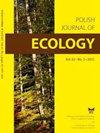纳米比亚Savanna Biome五种水貂(Scincidae:Mabuyinae)的日粮
IF 0.7
4区 环境科学与生态学
Q4 ECOLOGY
引用次数: 0
摘要
摘要:生活在干旱环境中的蜥蜴,尤其是石龙子(Scincidae),是检验生态位分化及其他相关种间竞争问题的良好研究对象。通过胃内容物分析,研究了5种棘龙(T. punctulata, T. binotata, T. capensis, T. wahlbergii, T. damarana)的饮食。石龙子是在纳米比亚的稀树草原栖息地收集的。在所有这些物种中,主动觅食策略占主导地位。所有的石龙子种类几乎都只捕食昆虫。5种昆虫的主要食性为鞘翅目、直翅目、等翅目、膜翅目(蚁科)和幼虫。它们对特定石龙子种类食物中所有猎物的总体贡献从72.2%到100.0%不等。大多数猎物长度在10毫米以下,有些猎物长度在11-20毫米之间。雄性和雌性都捕食相同的猎物群体,但这些群体的比例有显著差异。一般来说,雄性捕食甲虫和蚱蜢更多,而雌性捕食蚂蚁更多。所有五种石龙子在旱季和雨季都记录了所有主要猎物群。食物生态位重叠度最高的是达玛拉纳T.与华氏T.(0.84),其次是布氏T.与点状T.(0.77)。capensis与T. punctulata在食物生态位上无重叠,capensis与T. binotata在食物生态位上有较低的重叠(0.26)。本文章由计算机程序翻译,如有差异,请以英文原文为准。
Diet of Five Trachylepis Skink Species (Scincidae: Mabuyinae) in Savanna Biome of Namibia
ABSTRACT Lizards, especially skinks (Scincidae) occurring in arid environments constitute good study objects to test niche differentiation and other related issues of interspecific competition. Diet of five Trachylepis skink (T. punctulata, T. binotata, T. capensis, T. wahlbergii, T. damarana) was studied through stomach content analysis. Skinks were collected in savanna habitats in Namibia. In all these species, active foraging strategy predominates. All skink species preyed almost exclusively on insects. Four insect taxa comprised the bulk of diet in all five species investigated: Coleoptera, Orthoptera, Isoptera, Hymenoptera (Formicidae) and larvae. Their overall contribution ranged from 72.2% to 100.0% of all prey items in the diet of particular skink species. Most prey items were below 10 mm long, some were 11-20 mm in length. Both males and females fed on the same prey groups, but there were marked differences in the proportions of these groups. In general, males preyed more on beetles and grasshoppers, while females – more on ants. All main prey groups were recorded both in dry and in wet season in all five skink species. Food niche overlap was the highest between T. damarana and T. wahlbergii (0.84), and between T. binotata and T. punctulata (0.77). No overlap in food niche was recorded between T. capensis and T. punctulata, and low overlap (0.26) between T. capensis and T. binotata.
求助全文
通过发布文献求助,成功后即可免费获取论文全文。
去求助
来源期刊

Polish Journal of Ecology
环境科学-生态学
CiteScore
1.10
自引率
0.00%
发文量
9
审稿时长
18-36 weeks
期刊介绍:
POLISH JOURNAL OF ECOLOGY (formerly Ekologia polska) publishes original scientific research papers dealing with all aspects of ecology: both fundamental and applied, physiological ecology, evolutionary ecology, ecology of population, community, ecosystem, landscape as well as global ecology. There is no bias regarding taxons, ecosystems or geographical regions.
 求助内容:
求助内容: 应助结果提醒方式:
应助结果提醒方式:


